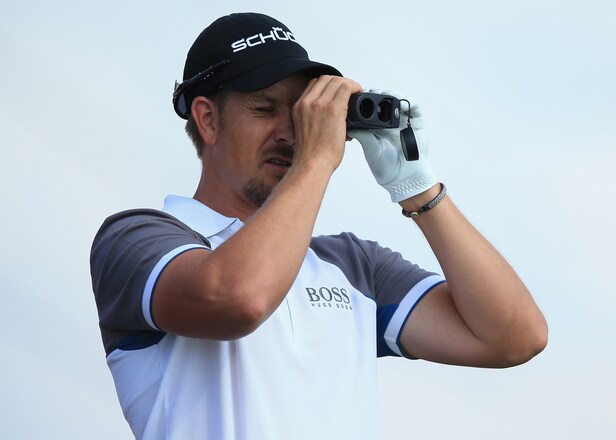For the first time, distance measuring devices, or rangefinders, will be allowed for use during a major at next week’s PGA Championship at Kiawah Island. The decision, announced in February, was made in an effort to speed up play. Whether it actually will and what impact the use of the devices will have on the tournament, we’ll get to that.
Some of the earliest rangefinders have a connection that traces to the birthplace of the game, Scotland. But they weren’t created for the purposes of sport. In 1891, Archibald Barr, an engineering professor at what is now the University of Leeds, and William Stroud, a physics professor at the same school, were asked by the department that oversaw the Royal Navy to design a short-base rangefinder.
One version was known as a coincidence rangefinder, which consisted of lenses and prisms at each end of a tube with a monocular eyepiece in the middle. It determined an object’s distance by measuring angles formed by a line of sight at each end of the tube. The smaller the angle, the greater the distance. The larger the angle, the shorter the distance. With the outbreak of World War I in 1914, the demand for rangefinders increased and the technology behind them continued to evolve.
The prevalence of distance measuring devices in golf, of course, wouldn’t come in earnest until much later.
In 1965, the first laser rangefinder was invented, replacing its more archaic and less accurate predecessor. Similar to radar, laser rangefinders measure distances by timing the interval between the transmission and reception of electromagnetic waves. In 1995, Bushnell launched its first laser rangefinder for golf, the Yardage Pro 400, which was about the size of a large pair of binoculars. While it was sometimes difficult to focus on a flag from 200 yards back then, the years since have seen the size of rangefinders shrink considerably while the accuracy and amount of information they produce has increased tremendously.
Though the Rules of Golf have allowed for the use of laser rangefinders and GPS devices in casual play and amateur tournaments since 2006, a local rule gave tournament committees the ability to ban the devices. As such, they still are not allowed during competition on any professional tour and aren’t permitted for the Masters, U.S. Open or Open Championship (though they are allowed during practice rounds at the professional level).
Then there’s the PGA of America, which runs the PGA Championship, as well as the Senior PGA, to be played later this month, and the KPMG Women’s PGA, set for June. It will allow rangefinders at all three events, making it the first major body in golf to permit the devices during professional competition. The decision was based in large part as a way to speed up play, according to PGA of America president Jim Richerson.
Few players and caddies who spoke to Golf Digest in advance of the PGA Championship, however, think it will improve pace. Many think the opposite will happen. The consensus is: Throw in the elements of a major championship being contested on a difficult course in Kiawah Island and things have the potential to drag even more.
“I think it may slow play down in certain scenarios where, if you’re trying to double-check [the numbers], that may not be great,” Bryson DeChambeau said. “But you have to play under a certain time period, so for the most part if players use it in a way that allows them to speed up play, that’s great. If they’re always double-checking, I think that’s a place where it could slow play down a little bit, which I am not a fan of at all.”
Leaving aside the irony of DeChambeau—among the most deliberate players on tour—saying he’s not a fan of slow play, there is validity to his point, according to many players and caddies.
“I’ll still have to have the front number, carry number, how many [yards] left or right and yards behind the pin,” said Webb Simpson’s caddie, Paul Tesori. “The last number we get is the pin, and what happens if the rangefinder is more than a yard off? Then we have to re-do all the other numbers to fit what we’re trying to do with the shot.”
“I feel like, this is a fact that it’s not going to speed up play, because everybody I know and have talked to, we still want front [of the green] numbers, and the rangefinder, you can’t always get the accurate front number,” Simpson said. “So you’ll probably have the player shoot the pin, the caddie walk off the number because I’m going to want, what’s front, what’s the pin? I haven’t read the reasoning behind it or their desire to test it out that week, but I don’t think it will really make a difference.”
Still, there are at least some scenarios where using a rangefinder could save time, particularly when a player hits a shot well off the fairway.
“We’re not going to have to go to a sprinkler head and walk 40, 50 yards away from a place to find a number,” DeChambeau said.
Not all the features that rangefinders provide will be useful. Though the technology of the devices has increased significantly in recent years, the only information that is allowed to be provided under the Rules of Golf is distance and direction. Devices that give elevation changes, wind speed or other data will not be permitted, just as they’re not in college or amateur tournaments.
As for whether players actually plan to use rangefinders altogether? It depends on whom you ask.
“I’ll probably still do the yardage book, me and the caddie,” said Jason Day. “I can understand if you, as a player, didn’t do yardages and you just were solely relying on it for your yardages. Then you could do it to double-check. But if you’re doing it and looking at a yardage book, it’s just one more thing.
“It’ll be interesting to see how many guys will do it. I’m not going to do it [in the PGA].”
Jordan Spieth says he and caddie Michael Greller will use a rangefinder but will do so as much for confirmation as anything.
“We have been checking our yardage books and cover numbers and back-of-green numbers for eight years now,” he said. “It’s not going to be we just step up, shoot it, and go. I mean, these pins get tucked and the wind’s blowing, and you’ve got to figure out a few more things than just the number to the hole.”
Even then, not everyone is for allowing rangefinders.
Aside from the potential to slow play down, it takes some of the acquired skill out of the job, for both player and caddie. Some also view it as just one more tool to make the task easier for everyone.
“I don’t really like them,” said Justin Thomas. “I think it takes away an advantage of having a good caddie that maybe goes out there and does the work beforehand. … Now, between the yardage books, the greens books and range finders, you technically don’t even really need to see the place or play a practice round. You can go out there and know exactly what the green does; you know exactly what certain things are on certain angles because you can just shoot it with the rangefinder.”

